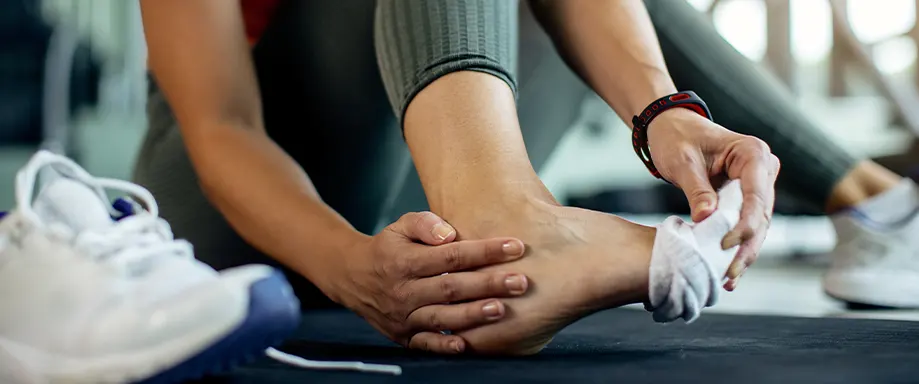Elevate the injured ankle

Elevating an injured ankle, especially in the case of an ankle sprain, can be immensely beneficial in improving your sleep and aiding in the healing process.
When you elevate the injured ankle, you're essentially raising it above the level of your heart. This position helps to reduce pain and swelling by encouraging better blood flow away from the injured area. It minimizes the accumulation of excess fluid and inflammation around the ankle, which can be a common source of discomfort.
So, don't even think twice – keep that ankle elevated!
Use a supportive pillow
Using a supportive pillow, such as a wedge pillow, when you have an injured ankle can significantly aid in getting a good night's sleep.
These pillows are designed to elevate your leg and provide support, which can help relieve pain and reduce swelling in the injured area. By maintaining the ankle in an elevated position, the pillow assists in promoting better blood circulation, preventing excessive fluid accumulation, and reducing inflammation.
Furthermore, a supportive pillow ensures that you can maintain a comfortable sleeping position that doesn't put undue pressure on the injured ankle. This alleviates discomfort and makes it easier to fall asleep, contributing to a restful night's rest during the recovery process.
Apply ice before bed

Applying an ice pack to the injured ankle can be another valuable strategy for obtaining a good night's sleep when dealing with ankle pain.
The RICE method, which stands for Rest, Ice, Compression, and Elevation, is a common approach to managing injuries. When you apply an ice pack to the injured area, it helps alleviate pain by numbing the nerves and reducing inflammation. This can make it more comfortable to rest and sleep. Ice is particularly effective in the initial stages of injury when swelling and pain are prominent. Cooling the affected area minimizes discomfort and creates conditions conducive to better sleep during the healing process.
Use a compression bandage
Compression bandages offer support and stability to the injured ankle, which can be especially important if you're experiencing severe pain or discomfort.
The compression helps secure the ankle bones in their proper position, reducing the risk of further injury and minimizing movement that could exacerbate the pain. It can also help control swelling and inflammation, contributing to a more comfortable and restorative sleep. By providing this added support and immobilization, a compression bandage can make it easier to relax and find relief, promoting a better night's rest while allowing the injured ankle to heal.
Choose the right mattress
The appropriate mattress (or let us say, the best mattress) ensures that you can find a comfortable sleeping position that minimizes pressure on the injured ankle.
Those with mild sprains may prefer softer mattresses that contour to their body and offer relief, while individuals with a more serious sprain might benefit from a firmer mattress that provides additional support. The right mattress contributes to better spinal alignment and pressure distribution, which can be essential for comfort and rest. By accommodating your specific needs and sleeping preferences, the right mattress enhances your chances of a restful night's sleep, even with an injured ankle.
Practice gentle ankle exercises before bed

Practicing gentle exercises before bed can be helpful when you have a sprained ankle, but it depends on the severity of the injury and your specific condition.
If your healthcare provider or physical therapist has recommended specific exercises as part of your rehabilitation, these exercises can aid in the healing process. Gentle range-of-motion exercises and stretching can improve ankle flexibility and reduce stiffness. However, it's essential to follow professional guidance and avoid any movements that may exacerbate the injury. For minor sprained ankles or when you're capable of walking short distances without significant pain, light exercises can help maintain circulation and muscle tone.
However, always consult a healthcare professional for personalised advice and exercises suitable for your specific situation to ensure you don't worsen the injury.
Use pain medication
In cases of severe sprains, pain can be intense and disruptive to rest. Pain medications can help manage discomfort, allowing you to find relief and sleep more comfortably. These medications can be especially valuable during the early stages of recovery when the pain is at its peak.
However, it's important to use them under the guidance of a healthcare professional and in conjunction with other treatments, such as physical therapy, to address the root cause of the injury. This multifaceted approach can contribute to a better night's rest, which is essential for the healing process.
Always have bedside essentials
Having bedside essentials like crutches, phone chargers, and other items can be a real sleep-saver when you're dealing with an injured foot.
When you're in a comfortable sleeping position with your injured foot properly elevated, it might be challenging to move around. In such situations, having your crutches or any mobility aids nearby means you won't have to struggle to get out of bed if you need to visit the bathroom or grab a snack. They're like your instant “get out of bed” cards.
Additionally, having first-aid supplies within arm's reach can be a lifesaver. You might need quick access to bandages or pain relief medication during the night, and having these essentials nearby ensures you can address any unexpected issues without having to hobble around.
Lastly, your phone charger is essential for keeping your phone ready, serving as your lifeline to communicate with friends or family if you need assistance in the middle of the night.
So, by having these bedside essentials, you're creating a sleep-friendly setup that's not only convenient but also safe and reassuring. They act as your sleep-time superheroes, ready to save the day (or night!) whenever you need them.
Conclusion
In conclusion, mastering the art of how to sleep with a sprained ankle can make a world of difference in your recovery journey.
By elevating your ankle, using supportive pillows, applying ice when needed, and, if necessary, employing braces or compression bandages, you can ease pain and reduce swelling, ultimately paving the way for a more restful night's sleep. Don't forget to keep your bedside essentials close for added comfort and safety. While sprained ankles may be a temporary setback, with the right strategies and a little patience, you can find the tranquility you need during those restless nights and wake up refreshed, one step closer to a full recovery.
So, here's to better sleep and a swifter healing process. Sweet dreams!















There are no comments yet
"*" indicates required fields